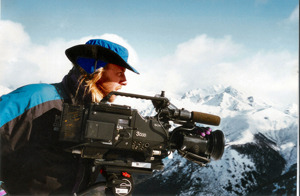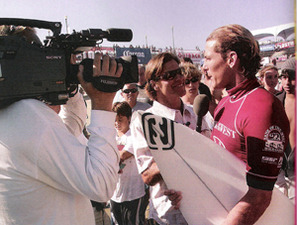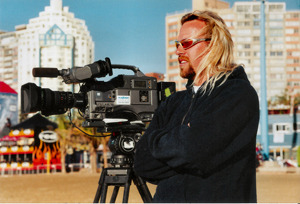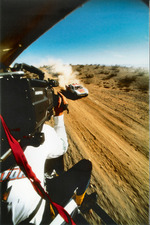San Clementean - The World thru a Lens
May 01, 2011 09:40PM ● By Brian O
Patrick Wallace, working in Dubai.
Well-traveled Cameraman, Patrick Wallace, settles down in San Clemente.
 by Don KindredTo the kids he’s simply Mr. Wallace, the tall, longhaired gentleman who teaches them about computers at Our Savior’s Lutheran School ... few would imagine the things he’s seen, the places he’s been or the experiences he’s had in his previous life... They might have missed him on the podium for the US Open of Surfing (27 times) or when he raced ahead of front runner Ivan “Ironman” Stewart’s Toyota Truck in the Baja 5000. They might not know he was on the slopes for the world pro ski tour in Corcheval, Chili, or seen his motorcycle take the lead in the deadly Kamikaze Downhill at Mammoth Mountain ... or know that he did them all backwards, with a camera on his shoulder and one eye shut. Patrick Wallace is a shooter, a cameraman, whose resumé has more credits than I have space. It contains two and a half decades of traveling the world as an industry-leading sports videographer and cinematographer. His sports and travel footage has been seen worldwide on all major broadcast and cable networks, including the National Geographic Channel, Discovery Channel, ESPN, Fox Sports, NBC, CBS, and a long-running shot in the well-known opening sequence to ABC’s “Wide World Of Sports. “I’ve come across a couple of parents who have recognized me”, Patrick says modestly about the anonymity of his new career. “Karch Kiraly’s kids went here and I knew him from shooting the Pro Volleyball tour, Colin McPhillips from the Pro Surfing Tour, and ESPN’s Kiana Tom, but mostly, I’m just Mr. Wallace, the computer teacher to my students,” he smiles. Early Influences  Wallace was raised in Laguna Beach. The passions that would shape his life; photography and motorsports, would be evident early, they were also inevitable. “I grew up in a family of car and motorcycle racers and motorsports journalists. For my 10th birthday my dad and his friend Joe Rusz, from Cycle World/Road& Track, gave me a 35 mm camera and took me to the old Ontario Motor Speedway for the 1972 AMA Motorcycle Road Racing Tour. They were both covering the race for their publications, so I even got to have my own press pass... I still have it. This gave me access to the inner sanctum of racing that I had never seen in magazines or on TV.” After seeing the “motorsports circus” up close he was hooked. When he finally reached the minimum age of 14, he joined a friend’s team, “And I started to spend my weekends in muddy white Levis filling tires with air and pouring nitro-methanol fuel into race cars at Ascot Park,” Wallace recalled. At fifteen a referral from his auto shop teacher got him the job with former N.H.R.A. drag racer and current I.M.S.A Sports Car driver Jim Busby. “I was only sweeping the floors and waxing the body work of his March/BMW M-1 GTP race car at his Coor’s/BMW race headquarters in Laguna Canyon.” At 16, he began traveling with the team on the road for the tour events. “I was in heaven,” he remembers. On Busby’s tour he had a chance encounter with filmmaker, and then San Clemente resident, Don Shoemaker. (Shoemaker had worked with Bruce Brown on the On Any Sunday series). He’d been working on a documentary about one of their drivers, former Olympian Bruce Jenner. He remembers the on-board cameras fascinated him at the time. Wallace had upgraded his photography equipment and was shooting a lot of black and white film which he could develop later in his home darkroom. “I spent as much time shooting our race cars as I did working on them,” he says, “My Team Pass had even better access than a Press Pass.” Wallace’s graduation from Laguna Beach High School came with the announcement that Jim Busby’s Race Team was folding. A job he planned on having “forever”.  At 18, he went full time on the circuit with two other race teams. He continued to enjoy the work but the 18-hour, 7-day-a-week schedule was more than he could put up with. The following September, Patrick enrolled at Saddleback College. Back to School Television became the perfect fit. His experience with photography blended quite naturally into this new enterprise called videography. “I was very fortunate to have taken my television classes at Saddleback at a time when some of the best shooters, producers, directors and talent of today were there getting their feet wet. Some of the more established class members were already working in the business, and they immediately sucked me into the whole mess. ESPN had just launched their cable networks as well, giving me [and the industry] more than enough work to fulfill.” Cashing his first television paycheck during his first semester was a blessing and a curse. “I was getting college credit and learning while at school, and I was getting on the job experience [and cash] while shooting local sports and music videos on the weekends ... which is why college took me seven years. Again, dad was not happy. He didn’t believe that this college hobby of mine could be turned into a career.” First Break While still at Saddleback, and shooting a S.C.O.R.E press conference in Anaheim, Wallace ran into his old acquaintance, Don Shoemaker, who was part of the panel. This time, it was Wallace’s camera that caught Shoemakers attention. (A borrowed Ikagami 730 ). “He came up to me after the conference to ask about the camera, asked for my card, and then called the next day. He asked if I could fly up to San Francisco for a day to shoot a made-for-television race. The S.C.C.A. was putting called “The Fast Five,” a five-car sprint race featuring the five drivers that had captured all of the poles that season. Don had secured eleven brand new Sony Beta cams for the event, (a camera I hadn’t even seen yet.) He asked me if I knew how to operate one. I lied, I said yes.” His stomach dropped when Shoemaker replied, “Great! You’ll be teaching the rest of the crew, none of them have seen one yet! “ The next morning, after borrowing a Beta cam manual, Patrick hopped on a plane and read as much as he could for the one-hour duration of the flight. When he arrived at SFO, he was driven to Sear’s Point Raceway in Sonoma where he met the rest of the crew, and as asked, he taught them the basics of the Sony Beta cam, based solely on what he had just read. “We all broke off to our camera positions just in time to shoot the feature race ... I had to wait thirty days to see that race on TV to know for sure if I had done it right. Don only waited five days before hiring me again for another gig ... the first of many.” Action-Chasing Career  With a camera, and about a thousand pieces of gear, he’s travelled the world, chasing and recording the variety of action sports at the highest levels; NASCAR, the pro watercraft tour, world-class skiing, boxing, motocross, skateboarding, snowboarding, surfing, mountain biking, base jumping, international track meets, swimming, biking, pro hockey, or anything else that fell, flew, ran, rolled, scored, sailed, surfed or slid. Wallace has witnessed “the thrill of victory, the agony of defeat” up close and personal. Patrick Wallace traveled to work through some 20 different countries, utilizing all normal modes of transportation and a variety of abnormal ones; such as an Air Force jet, a rickshaw, a mule and even the bullet train. He also managed to have a little fun along the way. He attended the royal birthday party for the King of Thailand; he shared burritos with the KGB in Russia, even raced remote controlled cars with Paul Newman. But in the end it was the rigorous challenge of today’s air travel that got to him. “When you’re traveling with all that gear, you’re used to getting things beat up and broken but after 9/11 it just got crazy. The security and scrutiny was occasionally leaving us with unusable equipment in remote locations where you couldn’t get it fixed. And it wasn’t just the gear that got broken as much as we did. It’s a grueling task to get what was sometimes sixty pieces of gear averaging 50 Lbs each through airport security, and then deal with foreign customs at the other end of an 18-hour flight.” One one trip, after flying to a pro ski event in Beriloche, Argentina, they were left without trucks, and all of the airport taxis were small 1950s-era sedans that could only carry three passengers and two equipment cases [one on the roof and one in the open trunk]. With cameras, tripods, support gear, skis, clothes and themselves,it took 15 taxis to get six of them to the hotel. Slowing Down “Television had pretty much drained me dry, so I accepted the school’s offer and started teaching seven years ago.“ Wallace explained. The road’s loss is the school’s gain, according to OSLS Principal Dunya Shaw. “He’s a hidden gem” she says, “not just a patient teacher for our computer lab, but he handles all our IT, even the computers in the other classrooms. He also he keeps our website up to date … and full of pictures, you know, he’s always got his camera, glued to his hip.” She continues, “And he just helped us re-design the new yearbooks, Patrick just doesn’t know how to say no.” Maybe that’s true, but he’s learning. On his own website, an entry describes his current life... “Semi-retired from the world of sports and entertainment television, Patrick has contentedly and enthusiastically gone back to his first love: Photography. No longer do sidelines and schedules bind him. Patrick has earned the right once again to shoot purely for his own enjoyment. While he has circled the globe many times over, Patrick’s life and home have always been at the beach; and it is there that you will most often find him, in shorts and bare feet and a camera in hand.” b For more on Patrick Wallace go to:www.patrickwallacephotography.com |




